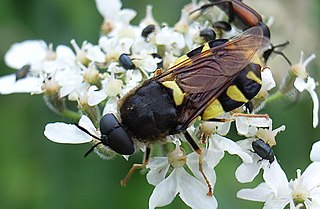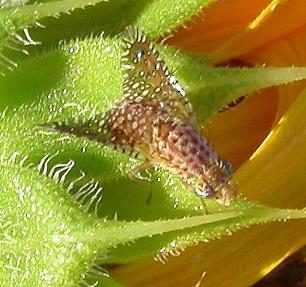
The Bombyliidae are a family of flies, commonly known as bee flies. Some are colloquially known as bomber flies. Adults generally feed on nectar and pollen, some being important pollinators. Larvae are mostly parasitoids of other insects.

Mario Bezzi was an Italian professor of zoology at the University of Turin. He was also director of the Turin Museum of Natural History. He was a Doctor of Science.

Rhagionidae or snipe flies are a small family of flies. They get their name from the similarity of their often prominent proboscis that looks like the beak of a snipe.

The Pyrgotidae are an unusual family of flies (Diptera), one of only two families of Cyclorrhapha that lack ocelli. Most species are "picture-winged", as is typical among the Tephritoidea, but unlike other tephritoids, they are endoparasitoids; the females pursue scarab beetles in flight, laying an egg on the beetle's back under the elytra where the beetle cannot reach it. The egg hatches and the fly larva enters the body cavity of the beetle, feeding and eventually killing the host before pupating. In the United States, some species of Pyrgota and Sphecomyiella can be quite common in areas where their host beetles are abundant. Like their host beetles, these flies are primarily nocturnal, and are often attracted to artificial lights.
Chaetostomella is a genus of fruit flies in the family Tephritidae.
Pliomelaena is a genus of tephritid or fruit flies in the family Tephritidae.
Pherothrinax is a genus of tephritid or fruit flies in the family Tephritidae.
Rhabdochaeta is a genus of tephritid or fruit flies in the family Tephritidae.
Rhochmopterum is a genus of tephritid or fruit flies in the family Tephritidae.

Empis is a genus of dance fly found in the fly family Empididae.

Stratiomyini is a tribe of flies in the family Stratiomyidae.

Sargus iridatus, the iridescent centurion, is a European species of soldier fly.

Hemerodromiinae are a worldwide group of predatory flies in the family Empididae with raptorial forelegs.
Dicheniotes is a genus of tephritid or fruit flies in the family Tephritidae.

Empidinae, also called dance flies, are a subfamily of empidoid flies. They are mainly predatory flies like most of their relatives, and generally small to medium-sized. Most species are flower visitors and they can be effective pollinators.
Hilarempis is a genus of flies in the family Empididae.
Macrostomus is a genus of flies in the family Empididae.

Eutretini is a tribe of tephritid or fruit flies in the family Tephritidae.
Schistopterini is a tribe of tephritid or fruit flies in the family Tephritidae.
Eremomidas is a genus of flies in the family Mydidae.







